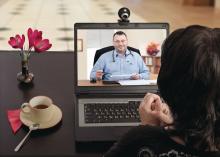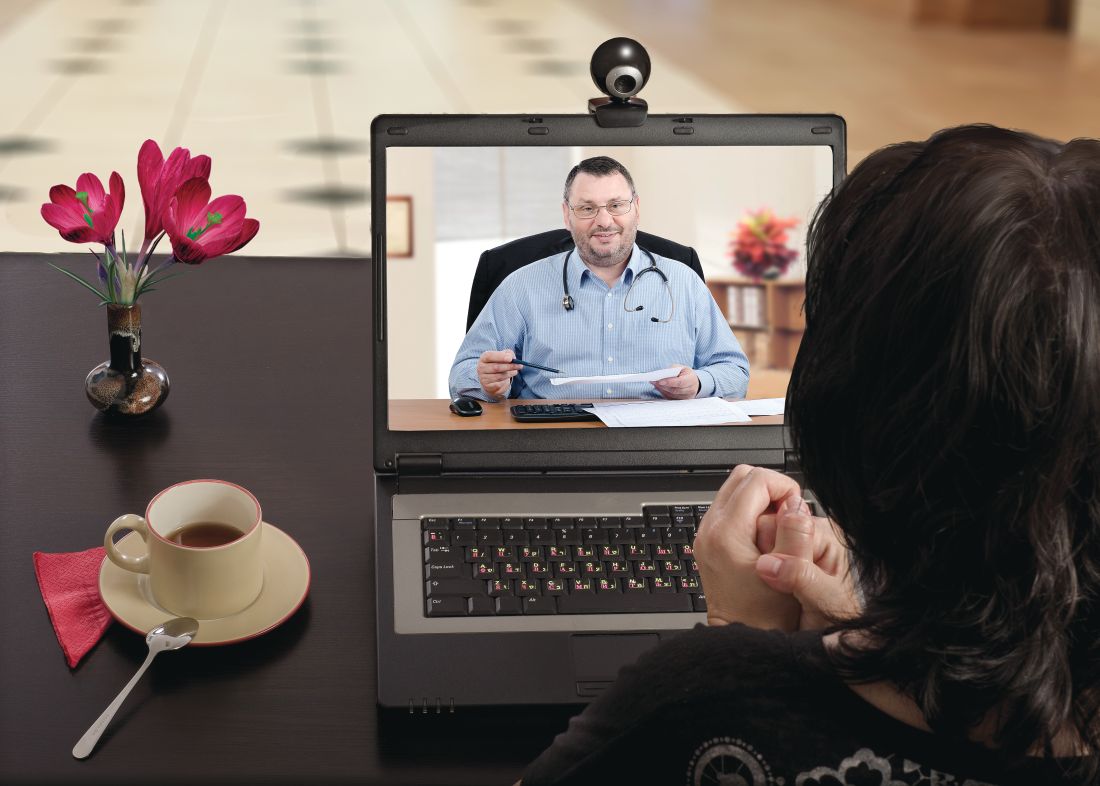User login
Expert panel reviewed best practices in 2020 while pandemic limited in-person visits
Tardive dyskinesia (TD) can be reasonably managed through telemedicine, but it should be employed as part of a hybrid strategy that ideally includes an office visit at the time of diagnosis and yearly intervals thereafter, according to an expert who spoke at a meeting presented by Current Psychiatry and the American Academy of Clinical Psychiatrists.
In psychiatry in general and in TD specifically, telepsychiatry is useful, but “is not a one-size-fits-all approach,” according to Rif S. El-Mallakh, MD, director of the mood disorder research program at the University of Louisville (Ky.).
Telepsychiatry was already growing as a strategy to expand psychiatric services to communities with limited resources in mental health when the COVID-19 pandemic arrived. Dependence on this type of patient care then exploded out of necessity but in advance of how it might best be applied in specific circumstances.
Best practices panel convened in 2020
The project to develop best practices in TD began in July 2020, when the pandemic was still limiting normal clinician-patient interactions. It was expected from the beginning that recommendations would be applicable to postpandemic circumstances.
There is no reason to expect the forces driving the growth of telepsychiatry, which include convenience of patients and efficiency for clinicians, to dissipate once the pandemic resolves, Dr. El-Mallakh said at the virtual meeting, sponsored by MedscapeLive.
, which consisted of six neurologists, three psychiatrists, and three psychiatric nurse practitioners. The goal was to gather information about the current practice of TD diagnosis and treatment in real-world settings.
With the information on current practices providing a baseline, a virtual roundtable was then convened to develop best-practices recommendations. The deliberations were performed on the basis of expert opinion. There were no statistical methods applied to data collected from the qualitative interviews.
Four key points in recommendations
The panel agreed on four key points: an in-person visit is preferred for initial evaluation and diagnosis; when applied for the evaluation of TD, telepsychiatry should include video; virtual visits cannot completely replace in-person visits; and patients with TD should be evaluated in person at least once per year.
In addition, the panelists recommended specific steps aimed at maximizing the quality of the virtual visit, including confirming that patients have appropriate equipment for video and audio communication. It is also important to recognize that patients or caregivers may require instruction on how to set up the equipment.
Prior to a telemedicine visit, it is appropriate to provide patients with a checklist that includes instructions on adequate lighting and audio. In addition, patient expectations about the goals and processes in the video should be explained.
“Instructional videos prior to the visit might be helpful,” Dr. El-Mallakh said.
Immediately prior to each visit, visual and audio quality should be verified. This allows technical issues, if any, to be resolved.
For the evaluation of TD, the ability to adequately observe body movements is crucial but can pose a challenge in telepsychiatry. To capture hyperkinetic movements and functional impairments with adequate clarity, it might be necessary to engage caregivers to hold the camera or otherwise help the clinician gain an adequate view. Clinicians should consider the limitations of telepsychiatry.
In addition to the challenges of a differential diagnosis for TD that should include such entities as parkinsonism and other drug-induced movement disorders, Dr. El-Mallakh cautioned, “comorbidities add another layer of complexity to TD diagnosis.”
Some in-office visits recommended
It is this complexity that led to the recommendation for an in-person evaluation for new-onset TD, although the expert panel did not characterize an initial in-office visit as mandatory.
Once a diagnosis of TD is established, telepsychiatry can be an efficient strategy for education and for confirming that treatments remain effective. However, Dr. El-Mallakh pointed out that patients can and often do have more than one drug-induced movement disorder at the time of diagnosis or develop additional clinical issues over time.
According to the expert panel, telepsychiatry should not be considered an adequate strategy to manage TD by itself, but “it can be an important component” of care of these patients if used judiciously.
“We have all come to recognize the benefits of telepsychiatry and some of the limitations,” said Jonathan M. Meyer, MD, clinical professor of psychiatry, University of California, San Diego. An author or coauthor of several articles on TD, including a recent study of patient awareness of TD symptoms while on vesicular monoamine transporter 2 inhibitors, Dr. Meyer identified technical problems as among the limitations.
“For movement disorders in particular, low bandwidth, poor video quality and lighting, and inadequate visualization of the trunk and limbs all present issues in diagnosing TD, scoring its severity, and differentiating it from other movement disorders,” he said.
“Nonetheless, I agree with the panel conclusions that in many instances, a video visit can be used to diagnose TD, assess severity, and monitor changes in symptoms over time,” he added, but he did express caution.
“For cases where the diagnosis is in doubt or where comorbid disorders require physical assessment, an in-person examination should be performed before embarking on any TD treatment strategy,” Dr. Meyer said.
MedscapeLive and this news organization are owned by the same parent company. Dr. El-Mallakh has ties with Allergan, Janssen, Lundbeck, Otsuka, Takeda, Teva, and Neurocrine Biosciences, which provided funding for this expert panel and summary. Dr. Meyer has ties with Acadia, Alkermes, Allergan, Merck, Neurocrine, Otsuka, Sunovion, and Teva.
Expert panel reviewed best practices in 2020 while pandemic limited in-person visits
Expert panel reviewed best practices in 2020 while pandemic limited in-person visits
Tardive dyskinesia (TD) can be reasonably managed through telemedicine, but it should be employed as part of a hybrid strategy that ideally includes an office visit at the time of diagnosis and yearly intervals thereafter, according to an expert who spoke at a meeting presented by Current Psychiatry and the American Academy of Clinical Psychiatrists.
In psychiatry in general and in TD specifically, telepsychiatry is useful, but “is not a one-size-fits-all approach,” according to Rif S. El-Mallakh, MD, director of the mood disorder research program at the University of Louisville (Ky.).
Telepsychiatry was already growing as a strategy to expand psychiatric services to communities with limited resources in mental health when the COVID-19 pandemic arrived. Dependence on this type of patient care then exploded out of necessity but in advance of how it might best be applied in specific circumstances.
Best practices panel convened in 2020
The project to develop best practices in TD began in July 2020, when the pandemic was still limiting normal clinician-patient interactions. It was expected from the beginning that recommendations would be applicable to postpandemic circumstances.
There is no reason to expect the forces driving the growth of telepsychiatry, which include convenience of patients and efficiency for clinicians, to dissipate once the pandemic resolves, Dr. El-Mallakh said at the virtual meeting, sponsored by MedscapeLive.
, which consisted of six neurologists, three psychiatrists, and three psychiatric nurse practitioners. The goal was to gather information about the current practice of TD diagnosis and treatment in real-world settings.
With the information on current practices providing a baseline, a virtual roundtable was then convened to develop best-practices recommendations. The deliberations were performed on the basis of expert opinion. There were no statistical methods applied to data collected from the qualitative interviews.
Four key points in recommendations
The panel agreed on four key points: an in-person visit is preferred for initial evaluation and diagnosis; when applied for the evaluation of TD, telepsychiatry should include video; virtual visits cannot completely replace in-person visits; and patients with TD should be evaluated in person at least once per year.
In addition, the panelists recommended specific steps aimed at maximizing the quality of the virtual visit, including confirming that patients have appropriate equipment for video and audio communication. It is also important to recognize that patients or caregivers may require instruction on how to set up the equipment.
Prior to a telemedicine visit, it is appropriate to provide patients with a checklist that includes instructions on adequate lighting and audio. In addition, patient expectations about the goals and processes in the video should be explained.
“Instructional videos prior to the visit might be helpful,” Dr. El-Mallakh said.
Immediately prior to each visit, visual and audio quality should be verified. This allows technical issues, if any, to be resolved.
For the evaluation of TD, the ability to adequately observe body movements is crucial but can pose a challenge in telepsychiatry. To capture hyperkinetic movements and functional impairments with adequate clarity, it might be necessary to engage caregivers to hold the camera or otherwise help the clinician gain an adequate view. Clinicians should consider the limitations of telepsychiatry.
In addition to the challenges of a differential diagnosis for TD that should include such entities as parkinsonism and other drug-induced movement disorders, Dr. El-Mallakh cautioned, “comorbidities add another layer of complexity to TD diagnosis.”
Some in-office visits recommended
It is this complexity that led to the recommendation for an in-person evaluation for new-onset TD, although the expert panel did not characterize an initial in-office visit as mandatory.
Once a diagnosis of TD is established, telepsychiatry can be an efficient strategy for education and for confirming that treatments remain effective. However, Dr. El-Mallakh pointed out that patients can and often do have more than one drug-induced movement disorder at the time of diagnosis or develop additional clinical issues over time.
According to the expert panel, telepsychiatry should not be considered an adequate strategy to manage TD by itself, but “it can be an important component” of care of these patients if used judiciously.
“We have all come to recognize the benefits of telepsychiatry and some of the limitations,” said Jonathan M. Meyer, MD, clinical professor of psychiatry, University of California, San Diego. An author or coauthor of several articles on TD, including a recent study of patient awareness of TD symptoms while on vesicular monoamine transporter 2 inhibitors, Dr. Meyer identified technical problems as among the limitations.
“For movement disorders in particular, low bandwidth, poor video quality and lighting, and inadequate visualization of the trunk and limbs all present issues in diagnosing TD, scoring its severity, and differentiating it from other movement disorders,” he said.
“Nonetheless, I agree with the panel conclusions that in many instances, a video visit can be used to diagnose TD, assess severity, and monitor changes in symptoms over time,” he added, but he did express caution.
“For cases where the diagnosis is in doubt or where comorbid disorders require physical assessment, an in-person examination should be performed before embarking on any TD treatment strategy,” Dr. Meyer said.
MedscapeLive and this news organization are owned by the same parent company. Dr. El-Mallakh has ties with Allergan, Janssen, Lundbeck, Otsuka, Takeda, Teva, and Neurocrine Biosciences, which provided funding for this expert panel and summary. Dr. Meyer has ties with Acadia, Alkermes, Allergan, Merck, Neurocrine, Otsuka, Sunovion, and Teva.
Tardive dyskinesia (TD) can be reasonably managed through telemedicine, but it should be employed as part of a hybrid strategy that ideally includes an office visit at the time of diagnosis and yearly intervals thereafter, according to an expert who spoke at a meeting presented by Current Psychiatry and the American Academy of Clinical Psychiatrists.
In psychiatry in general and in TD specifically, telepsychiatry is useful, but “is not a one-size-fits-all approach,” according to Rif S. El-Mallakh, MD, director of the mood disorder research program at the University of Louisville (Ky.).
Telepsychiatry was already growing as a strategy to expand psychiatric services to communities with limited resources in mental health when the COVID-19 pandemic arrived. Dependence on this type of patient care then exploded out of necessity but in advance of how it might best be applied in specific circumstances.
Best practices panel convened in 2020
The project to develop best practices in TD began in July 2020, when the pandemic was still limiting normal clinician-patient interactions. It was expected from the beginning that recommendations would be applicable to postpandemic circumstances.
There is no reason to expect the forces driving the growth of telepsychiatry, which include convenience of patients and efficiency for clinicians, to dissipate once the pandemic resolves, Dr. El-Mallakh said at the virtual meeting, sponsored by MedscapeLive.
, which consisted of six neurologists, three psychiatrists, and three psychiatric nurse practitioners. The goal was to gather information about the current practice of TD diagnosis and treatment in real-world settings.
With the information on current practices providing a baseline, a virtual roundtable was then convened to develop best-practices recommendations. The deliberations were performed on the basis of expert opinion. There were no statistical methods applied to data collected from the qualitative interviews.
Four key points in recommendations
The panel agreed on four key points: an in-person visit is preferred for initial evaluation and diagnosis; when applied for the evaluation of TD, telepsychiatry should include video; virtual visits cannot completely replace in-person visits; and patients with TD should be evaluated in person at least once per year.
In addition, the panelists recommended specific steps aimed at maximizing the quality of the virtual visit, including confirming that patients have appropriate equipment for video and audio communication. It is also important to recognize that patients or caregivers may require instruction on how to set up the equipment.
Prior to a telemedicine visit, it is appropriate to provide patients with a checklist that includes instructions on adequate lighting and audio. In addition, patient expectations about the goals and processes in the video should be explained.
“Instructional videos prior to the visit might be helpful,” Dr. El-Mallakh said.
Immediately prior to each visit, visual and audio quality should be verified. This allows technical issues, if any, to be resolved.
For the evaluation of TD, the ability to adequately observe body movements is crucial but can pose a challenge in telepsychiatry. To capture hyperkinetic movements and functional impairments with adequate clarity, it might be necessary to engage caregivers to hold the camera or otherwise help the clinician gain an adequate view. Clinicians should consider the limitations of telepsychiatry.
In addition to the challenges of a differential diagnosis for TD that should include such entities as parkinsonism and other drug-induced movement disorders, Dr. El-Mallakh cautioned, “comorbidities add another layer of complexity to TD diagnosis.”
Some in-office visits recommended
It is this complexity that led to the recommendation for an in-person evaluation for new-onset TD, although the expert panel did not characterize an initial in-office visit as mandatory.
Once a diagnosis of TD is established, telepsychiatry can be an efficient strategy for education and for confirming that treatments remain effective. However, Dr. El-Mallakh pointed out that patients can and often do have more than one drug-induced movement disorder at the time of diagnosis or develop additional clinical issues over time.
According to the expert panel, telepsychiatry should not be considered an adequate strategy to manage TD by itself, but “it can be an important component” of care of these patients if used judiciously.
“We have all come to recognize the benefits of telepsychiatry and some of the limitations,” said Jonathan M. Meyer, MD, clinical professor of psychiatry, University of California, San Diego. An author or coauthor of several articles on TD, including a recent study of patient awareness of TD symptoms while on vesicular monoamine transporter 2 inhibitors, Dr. Meyer identified technical problems as among the limitations.
“For movement disorders in particular, low bandwidth, poor video quality and lighting, and inadequate visualization of the trunk and limbs all present issues in diagnosing TD, scoring its severity, and differentiating it from other movement disorders,” he said.
“Nonetheless, I agree with the panel conclusions that in many instances, a video visit can be used to diagnose TD, assess severity, and monitor changes in symptoms over time,” he added, but he did express caution.
“For cases where the diagnosis is in doubt or where comorbid disorders require physical assessment, an in-person examination should be performed before embarking on any TD treatment strategy,” Dr. Meyer said.
MedscapeLive and this news organization are owned by the same parent company. Dr. El-Mallakh has ties with Allergan, Janssen, Lundbeck, Otsuka, Takeda, Teva, and Neurocrine Biosciences, which provided funding for this expert panel and summary. Dr. Meyer has ties with Acadia, Alkermes, Allergan, Merck, Neurocrine, Otsuka, Sunovion, and Teva.
FROM CP/AACP PSYCHIATRY UPDATE


